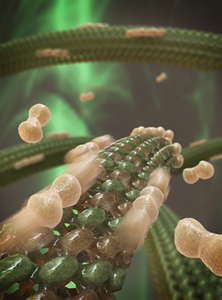Thursday, 11 August, 2016
Stopping the random walk
Biophysics
The cell’s internal skeleton undergoes constant restructuring. LMU physicists now show that its associated proteins can be efficiently transported to their sites of action by diffusion – provided they can be arrested when they get there.
The cells of higher organisms are stabilized by an internal skeleton, known as the cytoskeleton, which is made up of several families of proteins that form fibrous polymers. Members of one of these families polymerize to form so-called microtubules, which are essential for many cellular processes. To perform its many functions adequately, the cytoskeleton undergoes constant, dynamic restructuring under the influence of an array of regulatory proteins which, for instance, regulate the polymerization and depolymerization of the subunits that make up the microtubules. With the aid of a new theoretical model, researchers led by LMU biophysicist Erwin Frey have come up with a mechanism that allows these proteins to be efficiently transported to their sites of action. Their findings are reported in the journal Physical Review Letters.
Restructuring of existing microtubules requires binding of the appropriate regulatory proteins to either end of these polymers. – Given that microtubules are far larger than their modulators and consist of thousands of internal subunits to which the latter could potentially bind, finding the right end is no easy task. “Experimental studies of two such proteins have shown that they move diffusively – in other words, at random – along the microtubules,” says Emanuel Reithmann, first author of the new paper. “With the aid of simulations based on our new theoretical model, we have been able to reproduce the experimental data very successfully, and our analyses also demonstrate that diffusive motion actually helps the regulatory proteins to reach the right end of the polymer.”
But diffusion is not the whole story. A second factor plays the really crucial role: The proteins must be actively persuaded to put a halt to their diffusive wanderings at the end of the microtubule, i.e., they must allow themselves to be captured. Without some mode of capture at the end of the tubule, the protein misses its stop, and the positive effect of the diffusive motion is lost. Theoretical considerations suggest that energy is required to bring freely diffusing particles to a halt. “We therefore assume that contact with the end of the polymer triggers a reaction, which most probably requires the input of energy to alter the structure of the regulatory proteins so that they can be trapped,” Reithmann explains. “This hypothesis can now be further tested experimentally in order to get a better grasp of microtubular dynamics.” The researchers believe that their model should also be applicable to other types of regulatory molecules – such as DNA-binding proteins. The approach also yields new insights that are of general relevance to physical systems that are not in thermal equilibrium. – The dynamics of such non-equilibrium systems constitutes one the most active areas of investigation in modern theoretical physics.
Physical Review Letters 2016



 Pressemitteilung deutsch
Pressemitteilung deutsch